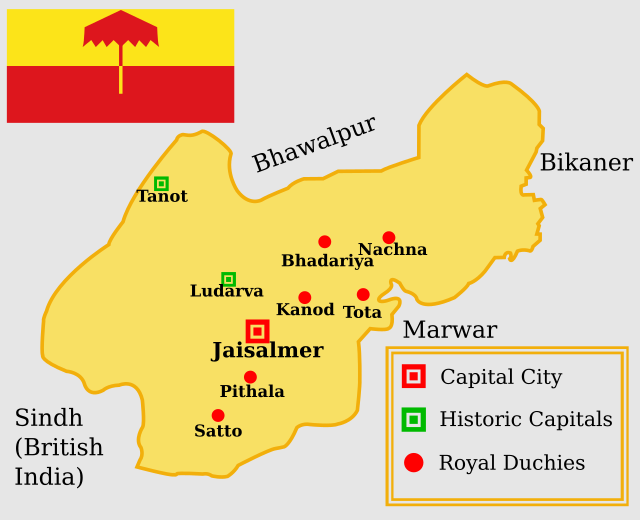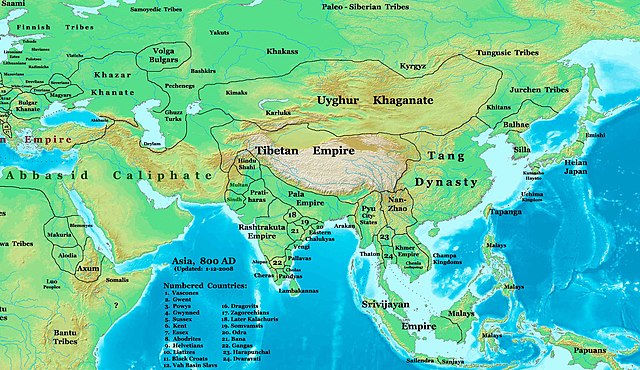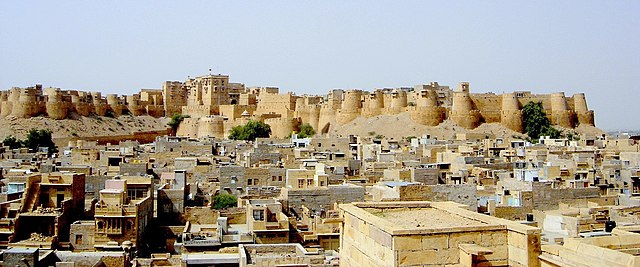Kingdom of Jaisalmer
Medieval Rajput kingdom in India From Wikipedia, the free encyclopedia
The Kingdom of Jaisalmer was a kingdom of Bhati Rajputs in the far-western part of present-day Rajasthan, India, from the mid-12th century CE until 1947. In 1156 CE, Rawal Jaisal moved his capital from Lodhruva to Jaisalmer because the former was vulnerable to attacks from Turko-Afghan and Baloch tribes. The descendants of Jaisal continued to exercise absolute control over Jaisalmer until 1818 CE, when a treaty of subsidiary alliance with the British East India Company bringing under British protection and sphere of influence. Known as the Maharawal, the native ruler of the princely state was entitled to a 15-gun salute.[3]
| Kingdom of Jaisalmer | |||||||||
|---|---|---|---|---|---|---|---|---|---|
| 1156–1947 | |||||||||
Jailsalmer State (orange) within Rajputana (yellow), 1909. | |||||||||
| Area | |||||||||
• 1931 | 41,600 km2 (16,100 sq mi) | ||||||||
| Population | |||||||||
• 1931 | 76,255 | ||||||||
| History | |||||||||
• Established | 1156 | ||||||||
| 1947 | |||||||||
| |||||||||
| Today part of | Rajasthan, India | ||||||||
| Coat of arms based on The Princely Armory. Publ. by The Office of the Superintendent of Government Printing. Calcutta. 1877 | |||||||||



History
Summarize
Perspective

Early history
The royal dynasty of Jaisalmer claims to be descended from the deified hero Krishna. Although the claims are not verified and there is no historical consensus regarding this. The Bhati rulers originally ruled parts of Afghanistan; their ancestor Rawal Gaj is believed to have founded the city of Gajni. According to James Tod, this city is present-day Ghazni in Afghanistan, while Cunningham identifies it as modern-day Rawalpindi.
His descendant Raja Salivahan is believed to have founded the city of Sialkot and made it his new capital. Salivahan defeated the Saka Scythians in 78 CE at Kahror, assuming the title of Saka-ari (foe of the Sakas). Salivahan's grandson Rao Bhati conquered several neighbouring regions. It is from him that the Bhati clan derives its name.[4]
Medieval history

The state of Jaisalmer had its foundations in what remains of the Empire ruled by the Bhati dynasty from the mid-12th century CE until 1947.[5] Early Bhati rulers ruled over large empire stretching from Ghazni[6] in modern-day Afghanistan to Sialkot, Lahore and Rawalpindi in modern-day Pakistan[7] to Bhatinda, Muktsar & Hanumangarh in Modern day India.[8] The empire crumbled over time because of continuous invasions from the central Asia. According to Satish Chandra, the Hindu Shahis of Afghanistan made an alliance with the Bhati rulers of Multhan, because they wanted to end the slave raids made by the Turkic ruler of Ghazni, however the alliance was defeated by Alp Tigin in 977 CE.[9] Bhati dominions continued to be shifted towards the South as they ruled Multan, then finally got pushed into Cholistan and Jaisalmer where Rawal Devaraja built Dera Rawal / Derawar.[10] Jaisalmer was the new capital founded in 1156 by Maharawal Jaisal Singh and the state took its name from the capital.

Modern history (Princely state of Jaisalmer)
On 11 December 1818 Jaisalmer became a British protectorate in the Rajputana Agency.[11][10]
Traditionally, in the Middle Ages, the main source of income for the kingdom was levies on caravans, but the economy was heavily affected when Bombay emerged as a major port and sea trade replaced the traditional land routes. Maharawal Ranjit Singh and Bairi Sal Singh attempted to turn around the economic decline but the dramatic reduction in trade impoverished the kingdom. A severe drought and the resulting famine from 1895 to 1900, during the reign of Maharawal Salivahan Singh, only made matters worse by causing widespread loss of the livestock that the increasingly agriculturally based kingdom relied upon.
The attempts of Maharawal Jawahir Singh (1914–1949) at modernization were also not entirely successful in turning the kingdom's economy around, and the drylands of Jaisalmer remained backward compared with other regions of Rajputana, especially the neighbouring state of Jodhpur. Nonetheless, the extensive water storage and supply, sanitation, and health infrastructures developed in the 1930s by the prime minister Dewan Bahadur Brijmohan Nath Zutshi provided significant relief during the severe droughts of 1941 and 1951. Maharawal During 1930–1947, Jawahir Singh and his ministers also promoted technical education and the academic disciplines of civil and mechanical engineering in the state.
After the departure of the British from India in 1947, the Maharawal signed an Instrument of Accession to the new Union of India, while retaining some internal autonomy until the 1950s.
List of rulers
Rawals
- Rawal Jaisal Singh (1153–1168), official founder of the kingdom
- Rawal Shalivahan Singh II (1168–1200)
- Rawal Bijal Singh (1200–1200)
- Rawal Kailan Singh (1200–1219)
- Rawal Chachak Dev Singh (1219–1241)
- Rawal Karan Singh I (1241–1271)
- Rawal Lakhan Sen (1271–1275)
- Rawal Punpal Singh (1275–1276)
- Rawal Jait Singh I (1276–1294)
- Rawal Mulraj Singh I (1294–1295)
- Rawal Durjan Sal (Duda) (1295–1306)
- Rawal Gharsi Singh (1306–1335)
- Rawal Kehar Singh II (1335–1402)
- Rawal Lachman Singh (1402–1436)
- Rawal Bersi Singh (1436–1448)
- Rawal Chachak Dev Singh II (1448–1457)
- Rawal Devidas Singh (1457–1497)
- Rawal Jait Singh II (1497–1530)
- Rawal Karan Singh II (1530–1530)
- Rawal Lunkaran Singh (1530–1551)
- Rawal Maldev Singh (1551–1562)
- Rawal Harraj Singh (1562–1578)
- Rawal Bhim Singh (1578–1624)
- Rawal Kalyan Das (1624–1634)
- Rawal Manohar Das (1634–1648)
- Rawal Ramchandra Dev (1648–1651)
- Rawal Sabal Singh (1651–1661)
Maharawals
- Maharawal Amar Singh of Jaisalmer (1661–1702)
- Maharawal Jaswant Singh of Jaisalmer (1702–1708)
- Maharawal Budh Singh (1708–1722)
- Maharawal Akhai Singh (1722–1762)
- Maharawal Mulraj Singh II (1762–1820)
- Maharawal Gaj Singh (1820–1846)
- Maharawal Ranjit Singh (1846–1864)
- HH Maharawal Sir Bairi Sal (1864–1891)
- HH Maharawal Sir Shalivahan Singh III (1891 –1914)
- HH Maharawal Sir Jawahar Singh (1914–1949),last ruler of the state.
- HH Maharawal Girdhar Singh (1949–1950), he was instrumental in merging his former state with Rajasthan Union in the year 1949 forming Greater Rajasthan in 1950.
Titular rulers
- Maharawal Raghunath Singh (1950–1982) Government of India abolished his right to the Privy Purse, hereditary titles and other privileges in 1971.
- Maharawal Brijraj Singh (1982–2020)
- Maharawal Chaitanya Raj Singh (since 2020)[12]
Dewans
- List of Dewans (chief ministers)
- Mohata Nathmal (1885–1890)
- Thakur kado singh (1890-1895)
- Mehta Jagjiwan (1895–1903)
- Thakur Kushal Singh (acting) (1890?–1900)
- Rawatmal Purohit Khetrapalia (acting) (1900–1909)
- Lakshmi Das Sapat (1909–1911)
- Mohammed Niyaz Ali Kazi (1911–1912)
- Murarji Rooji (1912–1930)
- M.L. Khosala
- Pandit Jamana Lal
- Munshi Nand Kishore
- Lala Rakhpat Raj
- P.K. Shurugula
- Brij Mohan Nath Zutshi
- Anand Swaroop
- Onkar Singh
- Lakhpat Rai Sikund (1940–1942)
References
External links
Wikiwand - on
Seamless Wikipedia browsing. On steroids.





